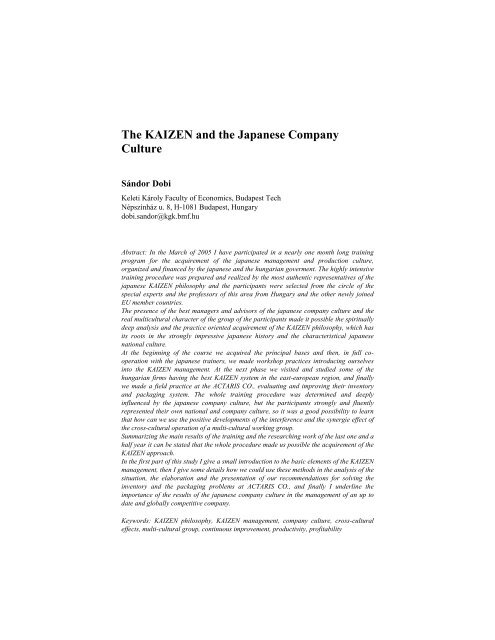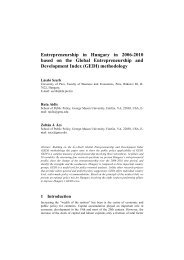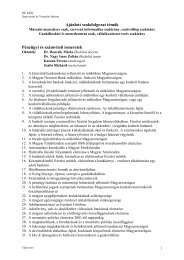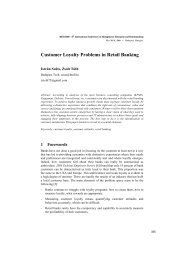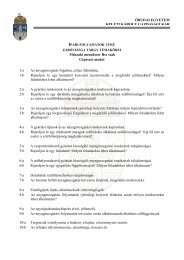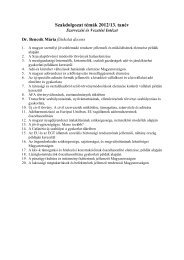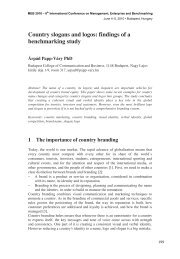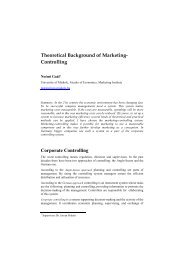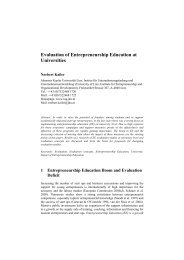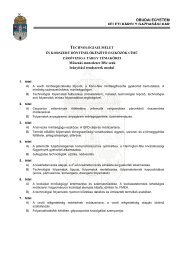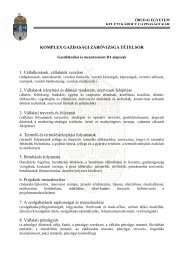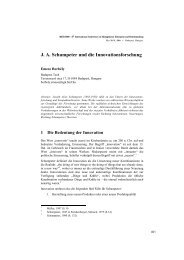The KAIZEN and the Japanese Company Culture
The KAIZEN and the Japanese Company Culture
The KAIZEN and the Japanese Company Culture
Create successful ePaper yourself
Turn your PDF publications into a flip-book with our unique Google optimized e-Paper software.
<strong>The</strong> <strong>KAIZEN</strong> <strong>and</strong> <strong>the</strong> <strong>Japanese</strong> <strong>Company</strong><br />
<strong>Culture</strong><br />
Sándor Dobi<br />
Keleti Károly Faculty of Economics, Budapest Tech<br />
Népszínház u. 8, H-1081 Budapest, Hungary<br />
dobi.s<strong>and</strong>or@kgk.bmf.hu<br />
Abstract: In <strong>the</strong> March of 2005 I have participated in a nearly one month long training<br />
program for <strong>the</strong> acquirement of <strong>the</strong> japanese management <strong>and</strong> production culture,<br />
organized <strong>and</strong> financed by <strong>the</strong> japanese <strong>and</strong> <strong>the</strong> hungarian goverment. <strong>The</strong> highly intensive<br />
training procedure was prepared <strong>and</strong> realized by <strong>the</strong> most au<strong>the</strong>ntic representatives of <strong>the</strong><br />
japanese <strong>KAIZEN</strong> philosophy <strong>and</strong> <strong>the</strong> participants were selected from <strong>the</strong> circle of <strong>the</strong><br />
special experts <strong>and</strong> <strong>the</strong> professors of this area from Hungary <strong>and</strong> <strong>the</strong> o<strong>the</strong>r newly joined<br />
EU member countries.<br />
<strong>The</strong> presence of <strong>the</strong> best managers <strong>and</strong> advisors of <strong>the</strong> japanese company culture <strong>and</strong> <strong>the</strong><br />
real multicultural character of <strong>the</strong> group of <strong>the</strong> participants made it possible <strong>the</strong> spiritually<br />
deep analysis <strong>and</strong> <strong>the</strong> practice oriented acquirement of <strong>the</strong> <strong>KAIZEN</strong> philosophy, which has<br />
its roots in <strong>the</strong> strongly impressive japanese history <strong>and</strong> <strong>the</strong> characteristical japanese<br />
national culture.<br />
At <strong>the</strong> beginning of <strong>the</strong> course we acquired <strong>the</strong> principal bases <strong>and</strong> <strong>the</strong>n, in full cooperation<br />
with <strong>the</strong> japanese trainers, we made workshop practices introducing ourselves<br />
into <strong>the</strong> <strong>KAIZEN</strong> management. At <strong>the</strong> next phase we visited <strong>and</strong> studied some of <strong>the</strong><br />
hungarian firms having <strong>the</strong> best <strong>KAIZEN</strong> system in <strong>the</strong> east-european region, <strong>and</strong> finally<br />
we made a field practice at <strong>the</strong> ACTARIS CO., evaluating <strong>and</strong> improving <strong>the</strong>ir inventory<br />
<strong>and</strong> packaging system. <strong>The</strong> whole training procedure was determined <strong>and</strong> deeply<br />
influenced by <strong>the</strong> japanese company culture, but <strong>the</strong> participants strongly <strong>and</strong> fluently<br />
represented <strong>the</strong>ir own national <strong>and</strong> company culture, so it was a good possibility to learn<br />
that how can we use <strong>the</strong> positive developments of <strong>the</strong> interference <strong>and</strong> <strong>the</strong> synergie effect of<br />
<strong>the</strong> cross-cultural operation of a multi-cultural working group.<br />
Summarizing <strong>the</strong> main results of <strong>the</strong> training <strong>and</strong> <strong>the</strong> researching work of <strong>the</strong> last one <strong>and</strong> a<br />
half year it can be stated that <strong>the</strong> whole procedure made us possible <strong>the</strong> acquirement of <strong>the</strong><br />
<strong>KAIZEN</strong> approach.<br />
In <strong>the</strong> first part of this study I give a small introduction to <strong>the</strong> basic elements of <strong>the</strong> <strong>KAIZEN</strong><br />
management, <strong>the</strong>n I give some details how we could use <strong>the</strong>se methods in <strong>the</strong> analysis of <strong>the</strong><br />
situation, <strong>the</strong> elaboration <strong>and</strong> <strong>the</strong> presentation of our recommendations for solving <strong>the</strong><br />
inventory <strong>and</strong> <strong>the</strong> packaging problems at ACTARIS CO., <strong>and</strong> finally I underline <strong>the</strong><br />
importance of <strong>the</strong> results of <strong>the</strong> japanese company culture in <strong>the</strong> management of an up to<br />
date <strong>and</strong> globally competitive company.<br />
Keywords: <strong>KAIZEN</strong> philosophy, <strong>KAIZEN</strong> management, company culture, cross-cultural<br />
effects, multi-cultural group, continuous improvement, productivity, profitability
1 <strong>The</strong> <strong>KAIZEN</strong> <strong>and</strong> its Possibilities in Hungary<br />
<strong>The</strong> <strong>Japanese</strong> word <strong>KAIZEN</strong> means gradual <strong>and</strong> orderly made, continous<br />
improvement. <strong>The</strong> <strong>KAIZEN</strong> business strategy involves everyone in an<br />
organization working toge<strong>the</strong>r to make improvements without large capital<br />
investments. <strong>KAIZEN</strong> is made of two elements improvement or change for <strong>the</strong><br />
better <strong>and</strong> continuity. Lacking one of <strong>the</strong>se elements would not be considered<br />
<strong>KAIZEN</strong>. This system can improve company productivity through Quality<br />
Improvement, Cost Reduction, shortened delivery, reduced lead time, inventroy<br />
control improvement, safety improvement. Innovation can be carried out on<br />
traditional way <strong>and</strong> by utilizing <strong>KAIZEN</strong>. <strong>The</strong> attributes of <strong>the</strong> traditional<br />
productivity improvement; introduction of new machinery <strong>and</strong> system, top down,<br />
big investment, result is not sure (a few big results) <strong>and</strong> on <strong>the</strong> o<strong>the</strong>r h<strong>and</strong><br />
<strong>KAIZEN</strong> relies on improvement of current machinery <strong>and</strong> system, bottom up,<br />
small investment, result is sure (a lot of small result), idea from all employees.<br />
<strong>KAIZEN</strong> is a widely used company management <strong>and</strong> productivity improvement<br />
method. Response of workers of different cultures to <strong>the</strong> introduceing of <strong>KAIZEN</strong><br />
varies region to region. <strong>The</strong>re are major difference between <strong>the</strong> European <strong>and</strong> <strong>the</strong><br />
Japenese behaviour of workers when <strong>the</strong>y have to face changes <strong>and</strong> have to apply<br />
new systems. <strong>The</strong>re are also historical reasons of aversion in Hungary. <strong>The</strong> 45<br />
years planned economy, <strong>the</strong> misused brigade movement <strong>and</strong> <strong>the</strong> distorted<br />
improvement movement planted a sceptical <strong>and</strong> pessimistic mentality deep into<br />
<strong>the</strong> peoples mind. Difficulties can be overcame by trainings, lectures <strong>and</strong> study<br />
tours etc. With highly committed leadership that guides people to continously<br />
improve <strong>the</strong>ir ability to meet <strong>the</strong> expectations of high quality, low cost <strong>and</strong> ontime<br />
delivery <strong>KAIZEN</strong> well proven profitability can change people’s mentality.<br />
2 <strong>The</strong> PULL, <strong>the</strong> JIT Production <strong>and</strong> <strong>the</strong> LEAN<br />
Manufacturing<br />
JIT is a <strong>Japanese</strong> management philosophy wich has been applied in practise since<br />
<strong>the</strong> early 1970s in many Japenese manufacturing compaines. It was developed <strong>and</strong><br />
perfected within Toyota manufacturing plants by Taiichi Ohno for meet <strong>the</strong><br />
consumer dem<strong>and</strong>s with minimum delays. Taiichi Ohno is frequently referred to<br />
as <strong>the</strong> fa<strong>the</strong>r of JIT. Toyota realised that JIT can only be successful if every<br />
individual within <strong>the</strong> organisation is involved <strong>and</strong> committed to it. JIT<br />
manufacturing has <strong>the</strong> capacity, when property tailored to <strong>the</strong> organisation, to<br />
streng<strong>the</strong>n <strong>the</strong> organisation’s competitiveness by reducing wastes <strong>and</strong> improving<br />
product quality <strong>and</strong> efficiency. In Japan <strong>The</strong>re are strong cultural aspect associated<br />
with <strong>the</strong> emergence of JIT. Ano<strong>the</strong>r aspect is that <strong>the</strong> production has to be<br />
switched over to PULL System from PUSH System. In case of push system <strong>the</strong><br />
producting quality is based on <strong>the</strong> dem<strong>and</strong> <strong>and</strong> stock. <strong>The</strong> components are made in
a sequential manner using <strong>the</strong> time st<strong>and</strong>ards for each operation. With PULL<br />
system <strong>the</strong> required quantity is withdrawn by <strong>the</strong> final process centre <strong>and</strong> in this<br />
way that process work centre withdraws <strong>the</strong> required quantity from its previous<br />
centre <strong>and</strong> so on. Thus this procedure works in reverse order.<br />
LEAN production system is an assembly-line manufacturing methodology<br />
developed originally for Toyota. <strong>The</strong> goal of lean production is described as to get<br />
<strong>the</strong> right time, <strong>the</strong> first time, while minimizing waste <strong>and</strong> being open to change.<br />
Engineer Ohno, who is credited with developing <strong>the</strong> principles of LEAN<br />
production, discovered that in addition to eliminating waste, his methodology led<br />
to improved product flow <strong>and</strong> better quality. Instead of devoting resources to<br />
planning what would be required for future manufacturing Toyota focused on<br />
reducing system response time so that <strong>the</strong> production system was capable of<br />
immediately changing <strong>and</strong> adapting to market dem<strong>and</strong>s. In effect, <strong>the</strong>ir<br />
automobiles became made-to-order. <strong>The</strong> principles of lean production enabled <strong>the</strong><br />
company to deliver on dem<strong>and</strong>, minimize inventory, maximize <strong>the</strong> use of multiskilled<br />
employees, flatten <strong>the</strong> management structure, <strong>and</strong> focus resource where<br />
<strong>the</strong>y were needed. <strong>The</strong> following principles pronounced by Womack: SPECIFY<br />
what does <strong>and</strong> does not create value from <strong>the</strong> customer’s perspective. IDENTIFY<br />
all <strong>the</strong> steps necessary to design, order <strong>and</strong> produce <strong>the</strong> product. Make those<br />
actions that create value. FLOW without preemption, detours, backflows, waiting<br />
or scrap. Only make what is PULLED by continually removing successive layers<br />
of waste as <strong>the</strong>y are uncoverd.<br />
3 <strong>The</strong> 5S Method <strong>and</strong> <strong>the</strong> Total Productive<br />
Maintenance<br />
One of <strong>the</strong> targets of a company is to create Value Added by production. <strong>The</strong> way<br />
to generate more VA is to increase income or/<strong>and</strong> decrease costs. <strong>The</strong> method of<br />
increasing VA is to improve productivity by increase quantity <strong>and</strong>/or reduce<br />
waste. <strong>The</strong> fields of productivity improvement are as follows: production, quality,<br />
cost, delivery, safety <strong>and</strong> moral. <strong>The</strong> definiton of 5S: SEIRI Sort out unnecessary<br />
items in <strong>the</strong> workplace <strong>and</strong> discard <strong>the</strong>m. SEITON Arrange necessary items in a<br />
good order so that <strong>the</strong>y can be easily piscked up for use. SEISO Clean your<br />
workplace completely so that <strong>the</strong>re is no dust on floor <strong>and</strong> equipment. Seiketsu<br />
Maintain high st<strong>and</strong>ard of housekeeping <strong>and</strong> workplace organisation at all times.<br />
When 3S (Seiri, Seiton, Seiso) is implemented correctly your workshop floor will<br />
change <strong>and</strong> become beautiful. This state is called „Seiketsu”. Shitsuke Train<br />
people to follow good housekeeping disciplines autonomously. <strong>The</strong> three main<br />
management system TQM, JIT <strong>and</strong> TPM are all based on 5S <strong>and</strong> continous<br />
improvement <strong>and</strong> this system helps a company to generate profit.
Maintenance makes easy for technology to perform appropriate effect for<br />
business. In <strong>the</strong> competitive enviorment technology is <strong>the</strong> physical manifestation<br />
of knowledge. TPM combines American Preventive Maintenance practice <strong>and</strong><br />
<strong>Japanese</strong> Total Quality Control. <strong>The</strong> result is an innovative system that optimizes<br />
efficiency, prevents machine breakdowns <strong>and</strong> supports <strong>the</strong> autonomous<br />
maintenance in <strong>the</strong> daily practice. TPM target is to maximize <strong>the</strong> efficient use of<br />
<strong>the</strong> machine during <strong>the</strong> whole life cycle. <strong>The</strong> operation of TPM needs <strong>the</strong><br />
involvement of all organization units at all levels. This motivates <strong>the</strong> teamwork<br />
<strong>and</strong> <strong>the</strong> autonomous activity. TPM includes <strong>the</strong> improvement of <strong>the</strong> operational<br />
<strong>and</strong> maintenance system, <strong>the</strong> implementation of good housekeeping <strong>and</strong> <strong>the</strong><br />
improvement of problem sloving ability to be able to achieve „ZERO” breakdown.<br />
<strong>The</strong> top management should prepare an evaluation system. Based on <strong>the</strong><br />
evaluation system, <strong>the</strong> ability <strong>and</strong> responsibility of <strong>the</strong> employee should be<br />
appreciated or rewarded as well.<br />
4 Field Practice at ACTARIS <strong>Company</strong><br />
Actaris is <strong>the</strong> only international group entirely dedicated to metering products <strong>and</strong><br />
systems for <strong>the</strong> distribution <strong>and</strong> allocation of electricity, gas, water <strong>and</strong> heat. <strong>The</strong><br />
word leader in its market, for all metertypes <strong>and</strong> classes, Actaris is <strong>the</strong> preferred<br />
partner of public <strong>and</strong> private water <strong>and</strong> energy suppliers, utility services<br />
compaines as well as industrial organisations. In order to respond to all customers’<br />
needs, Actaris offers a complete range of products covering all market segments:<br />
residental, commercial <strong>and</strong> industrial, transport <strong>and</strong> distribution, etc. With <strong>the</strong> aim<br />
of delivering <strong>the</strong> best service at a local level, Actaris relies on a network of 6,500<br />
employees spread over thirty countries, with a significant presence in Europe,<br />
Asia <strong>and</strong> South America.<br />
For <strong>the</strong> field practice <strong>the</strong> following tasks were given by management: Packaging<br />
<strong>and</strong> inventory. <strong>The</strong> target 2000 units/shift output at packaging, reduce WIP
plates. Average WIP is too high which slows down production, <strong>and</strong> takes up<br />
significant place.<br />
On <strong>the</strong> o<strong>the</strong>r h<strong>and</strong> we experidenced positive things as well. Workers sometimes do<br />
o<strong>the</strong>r jobs according to <strong>the</strong> capacities. <strong>The</strong>re are st<strong>and</strong>ard lead times for calibration<br />
by type of meters. <strong>The</strong>y have detailed analysis of <strong>the</strong> failures by type. Innovation<br />
team started his work almost one year ago with <strong>the</strong> support of <strong>the</strong> top<br />
management. 5S movement have been already started in October. <strong>The</strong>re were lot<br />
of improvements in <strong>the</strong> last half-year. Management devoted to manage <strong>the</strong> change<br />
for <strong>the</strong> improvement. <strong>The</strong>y develop <strong>the</strong> vendor’s network ambitiously. Goals in<br />
<strong>the</strong> field of calibration <strong>and</strong> packaging are as follows. <strong>The</strong>y targeting to raise <strong>the</strong><br />
units/shift output at packaging reduce WIP, optimize calibration.<br />
At packaging various problems were found. <strong>The</strong>re is no planning by product so<br />
<strong>the</strong> performance uneven <strong>and</strong> uncontrolled. Unbalanced work times, idle time in<br />
<strong>the</strong> process, lack of material, low cleaning st<strong>and</strong>ard at <strong>the</strong> lines creates quality<br />
problems. At <strong>the</strong> storage of components <strong>and</strong> parts <strong>the</strong>re is no visualization. No<br />
colorcoding for different type of meters. Ad hoc allocation of workers. Workers<br />
decide <strong>the</strong>ir job allocation without supervision. Problems were found concerning<br />
WIP as well. Push system fills <strong>the</strong> WIP 1 (before calibration), <strong>the</strong> same push<br />
system fills WIP 2 (after calibration). No visualization of origin or product type of<br />
<strong>the</strong> WIP. Problems with <strong>the</strong> calibration. <strong>The</strong>re were no planning, no types are<br />
taken into account, st<strong>and</strong>ard times for different categories are not realistic for<br />
some types, <strong>the</strong> push system can not optimize <strong>the</strong> usage of <strong>the</strong> calibration area, no<br />
in process st<strong>and</strong>ardization times only 7 types are defined, a waste in line capacity<br />
due to <strong>the</strong> mismatch with <strong>the</strong> order side, free capacity of workers is not utilized to<br />
increase production, lengthy process longer.<br />
Our proposals for packaging area: By Planning <strong>the</strong> Output <strong>and</strong> Allocation of<br />
people we can increase <strong>the</strong> utilization of workstations. It is recommended to<br />
balance <strong>the</strong> work load, reduce idle time, improve suplier management for plates,<br />
introduce 5S. New target to achieve is 2300/shift, it is currently varies from 800 to<br />
1800/shift.<strong>The</strong> present target is 2000/shift. During <strong>the</strong> implementation daily,<br />
weekly <strong>and</strong> monthly plan should be made. Job allocation ought to be changed,<br />
daily worker orientation is necessary at <strong>the</strong> beginning of <strong>the</strong> shift. Idle time<br />
reduction is needed. O<strong>the</strong>r supplier must be found to avoid <strong>the</strong> lack of material. 5S<br />
pilot area should be designated. Proposals concerning W.I.P: Introduce<br />
’KANBAN like’ system, cards should be used for pulling <strong>the</strong> material. <strong>The</strong> pull<br />
signal starts at packaging according to shift production plan. Kanban cards must<br />
be finalized during implementation. Teaching <strong>the</strong> use of ’KANBAN like’ cards is<br />
necessary as well as <strong>the</strong> one day teaching for <strong>the</strong> shipleaders <strong>and</strong> management.<br />
Employees ahould be trained by <strong>the</strong> supervisor.<br />
Proposals for optimizing <strong>the</strong> calibration: Usage of st<strong>and</strong>ard times for each type of<br />
meter, new tools for work places <strong>and</strong> operations are recommended, to change plan<br />
by shift/day in calibration area in correlation with special orders. Use st<strong>and</strong>ard
operation times for each line operation. New tools for work places <strong>and</strong> operations.<br />
Decrease defective rate of meters. New target Is to increase <strong>the</strong> calibration of<br />
meters from 1000 to 1400 units/shift current level is 810 units/shift.<br />
Implementation: Proposals would be implemented in function of data collection<br />
<strong>and</strong> measurements. <strong>KAIZEN</strong> <strong>and</strong> continous process improvement <strong>and</strong> monitoring<br />
is necessarry.<br />
Conclusions<br />
At <strong>the</strong> end of this study after participating in <strong>the</strong> mentioned training course <strong>and</strong><br />
after visiting a lot of companies using <strong>the</strong> <strong>KAIZEN</strong> management it can not be said<br />
that; it is <strong>the</strong> time to give <strong>the</strong> final conclusions of our topic, so we should make a<br />
lot of work in <strong>the</strong> future to reach some final results. But, of course, at this moment<br />
we have already some „preliminany” or „semi-final” results <strong>and</strong> <strong>the</strong>se are as<br />
fallows.<br />
• <strong>the</strong> japanese management <strong>and</strong> production culture has a good position in<br />
<strong>the</strong> global competition<br />
• this <strong>KAIZEN</strong> approach is in a close connection with <strong>the</strong> japanese<br />
national <strong>and</strong> company culture<br />
• a lot of o<strong>the</strong>r companies (not japanese) apply <strong>the</strong>se methods to improve<br />
<strong>the</strong>ir productivity <strong>and</strong> profitability with different results.<br />
• <strong>the</strong> main reasons of <strong>the</strong> weak results are, <strong>the</strong> negligation of <strong>the</strong> strong<br />
connection between <strong>the</strong> national <strong>and</strong> <strong>the</strong> company culture <strong>the</strong><br />
misunderst<strong>and</strong>ing of <strong>the</strong> <strong>KAIZEN</strong> approach <strong>and</strong> <strong>the</strong> insufficient<br />
preparation work for <strong>the</strong> application of a management philosophy in an<br />
o<strong>the</strong>r cultural environment.<br />
• after all of <strong>the</strong>se we can state that; we should know <strong>the</strong> essence <strong>and</strong> <strong>the</strong><br />
details of <strong>the</strong> japanese company culture, <strong>the</strong> new cultural environment<br />
<strong>and</strong> we should make very detailed <strong>and</strong> precise activity in <strong>the</strong> course of<br />
<strong>the</strong> adaptation of a <strong>KAIZEN</strong> system.<br />
References<br />
[1] S<strong>and</strong>or Dobi: Report <strong>and</strong> recommendations on <strong>the</strong> energy system of<br />
VOLÁNBUSZ Corp. (2001)<br />
[2] S<strong>and</strong>or Dobi: Project plan for <strong>the</strong> reconstruction of <strong>the</strong> energy system of<br />
ALUMÍTIUMGYÁR Corp. (2002)<br />
[3] S<strong>and</strong>or Dobi: Analysis <strong>and</strong> recommendations for Monor-Dabas region in<br />
<strong>the</strong> field of energy system (2003)<br />
[4] Anna Francsovics – S<strong>and</strong>or Dobi: <strong>The</strong> evaluation of succes of <strong>the</strong> project<br />
controlling (2003)<br />
[5] János Soós: Economics for real estates (2002)
[6] Facilities Engineering <strong>and</strong> Management H<strong>and</strong>book Mc’Graw-Hill (2000)<br />
[7] Anna Francsovics – S<strong>and</strong>or Dobi: <strong>The</strong> Controlling in Logistic Projects<br />
(2004)<br />
[8] S<strong>and</strong>or Dobi:. Accomodation management <strong>and</strong> Facility Management<br />
(2004)<br />
[9] S<strong>and</strong>or Dobi: Accomodation Management (2003)<br />
[10] Michio Morishima: Why has Japan succeeded (Cambridge University<br />
Press 1982)<br />
[11] Miklós Marosi: <strong>Japanese</strong> <strong>and</strong> chinese management (Aula 2003)<br />
[12] Tajichi Ohno: Toyota Production System (Productivity Press 1988)<br />
[13] Dr György Kadocsa: Introduction to Management for Engineers (AMICUS<br />
2004)<br />
[14] Ágnes Szeghegyi, Barnabás Bede: Bivariate Spline Approximation of<br />
Fuzzy Functions <strong>and</strong> Its Use in Digital Terrain Modeling (4 th Slovakian –<br />
Hungarian Joint Symposium on Applied Machine Intelligence 2006)


